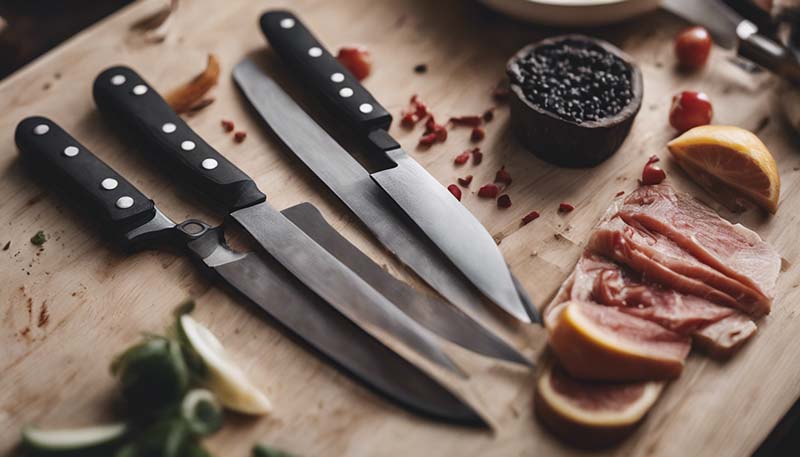The Ultimate Guide to Knife Skills for Home Cooks
Welcome to the ultimate guide to knife skills for home cooks. In this comprehensive guide, we will cover everything you need to know to master the art of using a knife in the kitchen. From choosing the right knife to advanced cutting techniques, this guide will help you become a more confident and efficient cook.
Table of Contents
- Introduction
- Choosing the Right Knife
- Basic Knife Skills
- Cutting Techniques
- Maintaining Your Knife
- Safety Tips
- Practice Makes Perfect
- Conclusion
Introduction
Knife skills are an essential part of cooking. They can make the difference between a tedious prep process and a seamless, enjoyable one. Whether you're a beginner or an experienced cook, mastering knife skills can significantly improve your efficiency in the kitchen and the quality of your dishes.
Choosing the Right Knife
Choosing the right knife is the first step in mastering knife skills. Here are some factors to consider when selecting a knife:
- Type of knife: Different knives are designed for different tasks. A chef's knife is a versatile choice for most cutting tasks, while a paring knife is great for small jobs like peeling or trimming.
- Sharpness: A sharp knife is safer and more efficient than a dull one. Test the sharpness by cutting a tomato or an onion; if it glides through easily, it's sharp enough.
- Comfort: Hold the knife and make sure it feels comfortable in your hand. A knife that's too heavy or awkward to hold can lead to fatigue and accidents.
- Material: Knives can be made from various materials, such as stainless steel, carbon steel, or ceramic. Each material has its own advantages and disadvantages in terms of sharpness, durability, and maintenance.
Basic Knife Skills
Before diving into advanced techniques, it's essential to master some basic knife skills:
- Holding the knife: Hold the knife handle firmly but not too tightly. Your grip should be relaxed and allow for some movement.
- Holding the food: Use your non-dominant hand to hold the food. Curl your fingers under, tucking the nail side against the blade to protect your fingertips.
- Cutting motion: Use a smooth, rocking motion to cut. Keep your knife at a slight angle and let the weight of the knife do the work.
- Slicing: For even, thin slices, use a gentle sawing motion, starting with the back of the knife and finishing with the tip.
Cutting Techniques
There are several cutting techniques that every home cook should know:
- Julienne: Cut the food into thin, matchstick-like strips.
- Dicing: Cut the food into small, uniform cubes.
- Mincing: Chop the food into very fine, almost paste-like pieces.
- Chiffonade: Stack the leaves of herbs or lettuce, roll them tightly, and then slice thin strips.
- Battenberg: Cut food into small, diamond shapes.
Maintaining Your Knife
Proper maintenance is crucial for keeping your knife sharp and in good condition:

- Cleaning: Hand-wash your knife with warm, soapy water after each use. Avoid putting it in the dishwasher, as the heat and detergent can damage the blade and handle.
- Sharpening: Regularly sharpen your knife using a honing rod or a sharpening stone. A dull knife is not only inefficient but also dangerous to use.
- Storage: Store your knife in a knife block, on a magnetic strip, or in a protective sheath. Avoid storing it with other knives to prevent damage to the blade.
Safety Tips
Safety should always be a top priority when using a knife:
- Focus: Always pay attention when using a knife. Avoid distractions and keep your mind on the task at hand.
- Steady hand: Keep a firm grip on the food you're cutting to prevent it from slipping.
- Use a cutting board: Always use a stable cutting board. A wobbly or thin board can be dangerous.
- Don't force it: Let the knife do the work. Don't force the blade through the food, especially if it's tough or frozen.
Practice Makes Perfect
Like any skill, knife skills improve with practice. Here are some tips for practicing:
- Start with easy foods: Practice on soft foods like onions, tomatoes, and fruits before moving on to more challenging ingredients.
- Consistency: Practice regularly to build muscle memory and improve your technique.
- Learn from others: Watch cooking shows, take a cooking class, or ask a more experienced cook for tips and advice.
- Be patient: Progress may be slow at first, but with consistent practice, you'll see improvement over time.
Conclusion
Mastering knife skills is an essential part of becoming a proficient home cook. By choosing the right knife, practicing regularly, and following safety guidelines, you can improve your efficiency in the kitchen and enjoy a more satisfying cooking experience. Remember, practice makes perfect, so keep at it, and soon you'll be a knife-wielding pro!
Leave a Comment